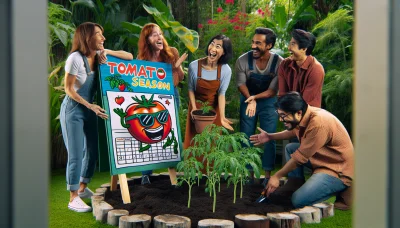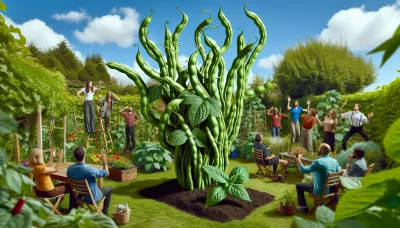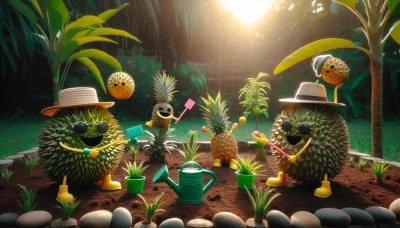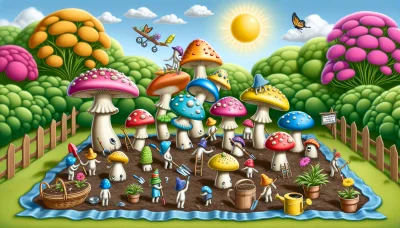Red tropical fruit Quiz
Test Your Knowledge
Question of
Exploring Red Tropical Fruits
Red tropical fruits offer a vibrant palette of flavors and colors that can add an exotic touch to any garden. From the juicy sweetness of strawberries and watermelons to the tart and tangy taste of cranberries and pomegranates, these fruits are not only delightful to the palate but also appealing to the eye. Growing red tropical fruits can be a rewarding experience, providing gardeners with a lush bounty of fresh produce while also enhancing the aesthetic appeal of their outdoor spaces. The diversity of red tropical fruits means there's always something new and exciting to discover and cultivate.
Top Red Tropical Fruits for Your Garden
- Lychee: Known for its sweet and tangy flavor, lychee has a rough red skin with a juicy, grape-like flesh inside. It is rich in vitamin C and B-complex.
- Rambutan: Similar to lychee, rambutan has a hairy red and green shell. Its juicy, creamy taste and nutritious seeds make it a favorite among tropical fruit lovers.
- Dragon Fruit (Red Pitaya): With its unique red skin and green scales, dragon fruit boasts a mildly sweet taste and contains small black seeds. It's high in fiber and antioxidants.
- Strawberry Guava: Smaller than the common guava, this fruit has a sweet and slightly tart flavor. Its red skin encases a pink to red flesh that's high in vitamin C.
- Watermelon: Known for its refreshing juice, watermelon's green exterior hides a sweet, red, and juicy interior. It's packed with vitamins A, C, and antioxidants.
- Red Banana: Richer and sweeter than its yellow counterpart, the red banana has a creamy flesh that is excellent for desserts or smoothies. It's a good source of potassium and vitamin C.
- Surinam Cherry: This small, pumpkin-shaped fruit has a tart flavor that sweetens as it ripens. Rich in vitamin C, it's perfect for jams, jellies, or eating fresh.
Cultivation Tips for Red Tropical Fruits
When growing red tropical fruits in your garden, it's essential to replicate their native, warm, and humid environment as closely as possible. Start by choosing a sunny spot, as most tropical fruits require full sun to thrive and produce fruit. Soil should be well-draining yet rich in organic matter; consider incorporating compost to improve soil fertility and structure. Regular watering is crucial, especially during dry spells, but be careful not to overwater. Mulching can help retain soil moisture and regulate temperature. Additionally, protect your plants from cold temperatures with covers or by bringing potted plants indoors if possible. With patience and proper care, you can enjoy a bountiful harvest of delicious red tropical fruits right from your garden.
Climate Requirements for Growing Red Tropical Fruits
| Fruit | Temperature (°C) | Humidity (%) |
|---|---|---|
| Lychee | 24 - 32 | 70 - 80 |
| Rambutan | 22 - 30 | 75 - 85 |
| Dragon Fruit | 21 - 29 | 50 - 60 |
| Watermelon | 25 - 35 | 60 - 80 |
| Pomegranate | 18 - 30 | 40 - 80 |
Pest Management in Red Tropical Fruit Gardening
Red tropical fruits, such as lychees, rambutans, and dragon fruits, are not only delicious but also highly nutritious. However, they are susceptible to various pests that can significantly affect their growth and yield. Common pests include fruit flies, which lay their eggs on the fruits, leading to infestation; aphids, which suck the sap from the leaves and stems, weakening the plant; and spider mites, which can cause the leaves to yellow and drop prematurely. To manage these pests, gardeners can employ several strategies. Regular monitoring of the plants for early detection of pests is crucial. Biological control methods, such as introducing natural predators of these pests into the garden, can help manage their population. Additionally, maintaining good garden hygiene by removing fallen fruits and leaves can reduce pest infestation. In some cases, the use of organic pesticides may be necessary, but they should be used judiciously to avoid harming beneficial insects and the environment.
Harvesting and Storing Your Red Tropical Fruits
To ensure the best taste and longest freshness for your red tropical fruits, it's crucial to harvest them at the right time and store them properly. Always pick fruits in the morning when it's cooler, as this helps retain their natural sugars. Look for fruits that are fully colored but still firm to the touch. For storage, keep unripe fruits at room temperature away from direct sunlight to allow them to ripen evenly. Once ripe, most red tropical fruits can be refrigerated to extend their freshness, but remember to bring them to room temperature before eating to enjoy their full flavor. Avoid washing fruits until you're ready to eat them to prevent premature spoilage.
Benefits of Growing Red Tropical Fruits
Growing red tropical fruits in your garden offers a myriad of health benefits alongside the sheer joy of gardening. These vibrant fruits are not only a feast for the eyes but are packed with essential vitamins, minerals, and antioxidants that promote heart health, improve digestion, and can even help in managing weight. The act of gardening itself is a rewarding endeavor, providing a sense of accomplishment and a direct connection to the food you eat. Moreover, the freshness and flavor of home-grown fruits are unparalleled, making every bite a delightful experience. Embrace the joy of gardening and the bounty of health benefits by incorporating red tropical fruits into your garden.












